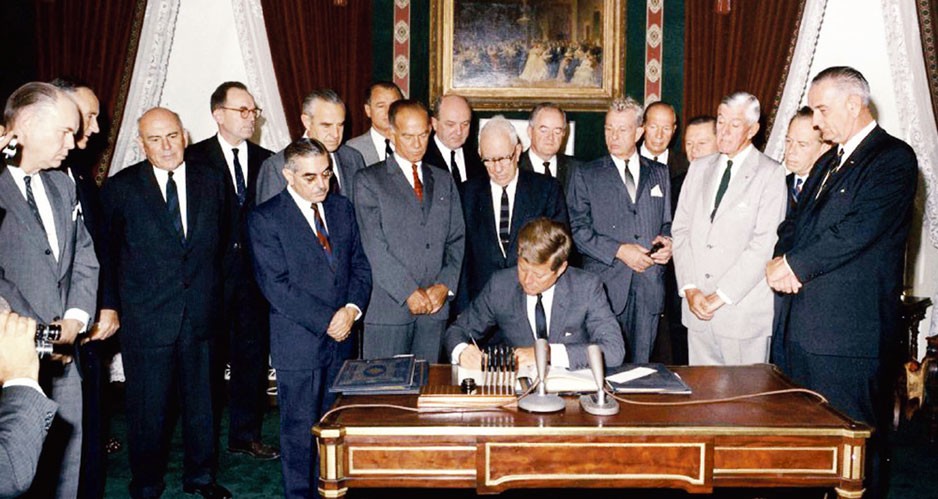There is no shortage of skeptics who question if nuclear weapons can ever be fully eliminated. Since nuclear weapon technology has already been invented, they will say, ‘the nuclear genie cannot be put back in its bottle.’ The argument goes that since nuclear technology cannot be un-invented, the elimination of nuclear weapons by treaty would be naïve.
It is true that nuclear know-how is with us forever. It is also true, that since this technology is known, there is the risk that some nations would cheat on a treaty banning nuclear weapons. However, we need to acknowledge that there are risks in either course. The risk of failing to agree to eliminate nuclear weapons globally is the continuation of nuclear proliferation with its incumbent risks of nuclear terrorism or accident.
One of the world’s first nuclear arms control agreements was the 1963 Partial Test Ban Treaty (PTBT). The PTBT presents a case study for balancing these comparative nuclear risks. Leading up to the Senate vote on this treaty, President John F. Kennedy said to Congress, “While it may be theoretically possible to demonstrate the risks inherent in any treaty… the far greater risk to our security are the risks of unrestricted testing, the risks of a nuclear arms race, the risks of new nuclear powers.”
The health risks of atmospheric nuclear weapons testing had become well understood in the late 1950’s and early 60’s. The Kennedy administration determined that the health benefits gained by ending radioactive fallout, combined with the potential non-proliferation benefits of this treaty, outweighed the strategic risks of signing it.
As in today’s debate over the Comprehensive Test Ban Treaty, in 1963 there were internal government critics of the PTBT from the Joint Chief of Staffs, to the nuclear weapons laboratory directors whose congressional testimonies conveyed dire warnings.
One Partial Test Ban Treaty strategic risk was well known in advance. Neither France nor China had any intention of signing the PTBT. Therefore, this would not be an equitable treaty as participation would not be inclusive. Yet the signing parties determined that while the treaty was imperfect, it was the lower risk alternative to not having a test ban treaty at all.
Responding to growing international pressures France finally stopped atmospheric testing in 1974 and China ended their atmospheric testing in 1980. Both nations eventually signed and ratified the PTBT. There have been no atmospheric nuclear weapons tests anywhere in the world since 1980.
The Chemical Weapons Convention (CWC) which bans the possession and use of chemical weapons had a similar uneven progression. Attempts to limit chemical weapons go all the way back to World War I. Yet it wasn’t until 1997 that the U.S. Senate ratified the chemical weapon ban. Today all but seven nations have ratified the CWC.
In 2003, ten years after signing the CWC, Albania announced it had uncovered a stockpile of chemical weapons. Skeptics may look at this incident as proof of the failure of arms control. Albania held onto their substantial chemical weapons arsenal (whether knowingly or not is up for question) long after signing the CWC.
But arms control proponents look at this Albanian disclosure as a success story. The end result was one more country coming clean and eliminating their stockpiles of banned weaponry without their use. Chemical weapon know-how is even wider spread than nuclear know-how. The ‘chemical genie’ cannot be put back into its bottle either. Nevertheless, we have determined we are made more secure by banning chemical weapons.
Governments are expected to assure the security of their citizens. The real challenge is in agreeing on the lowest risk path to security. Our arms control history shows the potential for achieving nuclear security by banning nuclear weapons through a verifiable arms control regime.
While there will no doubt be challenges, past history has shown that there are opportunities to strengthen and improve treaty regimes over time. But first nuclear weapons powers must commit to the path of a staged, global ban of all nuclear weapons as our lowest risk solution.

